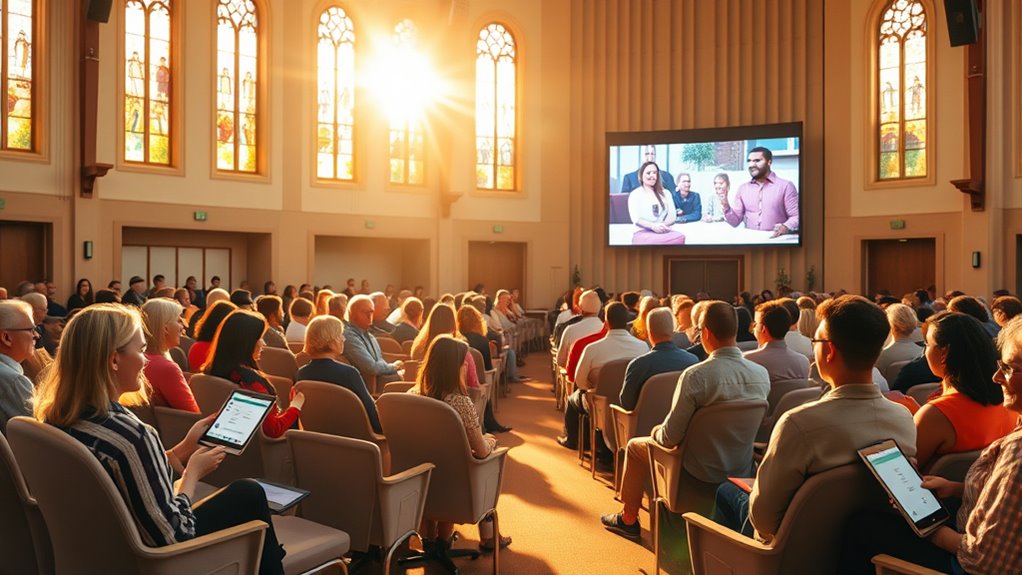To lead an effective hybrid ministry in 2025, you should focus on creating engaging, two-way digital platforms like live chat, discussion groups, and social media to foster community. Invest in high-quality audiovisual tech, support real-time interaction, and train your team to use these tools confidently. Regularly gather feedback and adapt strategies to meet your community’s evolving needs. Keep exploring new tech and engagement methods to build stronger, inclusive connections—that’s just the beginning of what’s possible.
Key Takeaways
- Integrate interactive features like live chat and discussion groups to foster community engagement both online and onsite.
- Invest in high-quality audiovisual and visual technology to create immersive, inclusive worship experiences.
- Provide ongoing training for leaders and volunteers on digital tools to enhance virtual and hybrid interactions.
- Utilize church management software to monitor engagement, gather feedback, and adapt strategies accordingly.
- Promote two-way communication through personalized messages and virtual events to deepen connections and encourage participation.

As churches embrace the evolving landscape of ministry in 2025, mastering hybrid models has become essential for reaching and engaging your congregation effectively. You need to find ways to connect with both in-person attendees and those joining remotely, which requires a strategic approach to community engagement and technology integration. The goal is to foster a unified and vibrant church community that feels inclusive regardless of how members participate. To do this, you must leverage technology not just as a tool but as a bridge that brings everyone closer together.
Start by intentionally designing your digital platforms to encourage interaction. This means integrating live chat features during streaming services, creating online discussion groups, and using social media to facilitate ongoing conversations. When your congregation feels seen and heard, whether they’re in the pews or on their screens, they’re more likely to develop a sense of belonging. Community engagement isn’t just about broadcasting content; it’s about creating two-way communication channels that sustain relationships and deepen connections.
Design digital platforms to foster interaction and create two-way communication channels that deepen community bonds.
Technology integration should go beyond simply streaming sermons. Invest in quality audiovisual equipment that ensures a seamless experience for remote viewers. Use platforms that allow for real-time interaction, such as virtual prayer rooms or small group meetings that can be accessed from anywhere. Additionally, consider utilizing church management software that helps you track engagement levels, facilitate volunteer coordination, and send personalized messages. These tools keep your community connected and informed, fostering a sense of involvement that transcends physical boundaries.
You also need to train your team to be comfortable with these technologies. Providing ongoing training ensures everyone understands how to make the most of digital tools to enhance community engagement. Encourage your leaders to host virtual meet-and-greets, Q&A sessions, and online workshops that invite participation. When your congregation sees your genuine efforts to include everyone, they’ll feel more invested in the mission and activities of the church.
Furthermore, understanding the importance of projector technology can enhance visual presentations and sermons, making remote participants feel more connected through vibrant visuals. When your congregation sees engaging, high-quality images and videos, it improves overall engagement and comprehension.
Finally, listen to your community’s feedback. Regularly ask for input on how your hybrid model is working and be willing to adapt. As technology evolves and your congregation’s needs change, stay flexible and innovative. By prioritizing community engagement through effective technology integration, you’ll create a hybrid ministry environment that is dynamic, inclusive, and impactful in 2025. This approach not only sustains your congregation but also helps it grow by making everyone feel valued and connected, no matter where they are located.
Frequently Asked Questions
How Can Hybrid Ministry Adapt to Future Technological Advances?
To adapt to future technological advances, you should embrace virtual collaboration tools that enhance communication and community building. Keep up with digital transformation by regularly updating your platforms and training your team. This way, you guarantee seamless engagement whether in person or online. Staying flexible and open to new innovations allows your hybrid ministry to remain relevant, effective, and connected no matter how technology evolves.
What Are the Key Metrics for Measuring Hybrid Ministry Success?
You should focus on key metrics like attendance tracking to monitor engagement levels across online and in-person services. Additionally, gather participant feedback regularly to understand their spiritual growth and satisfaction. These metrics help you identify what’s working and where improvements are needed. By analyzing attendance patterns and listening to feedback, you can refine your hybrid ministry strategies to better serve your community and foster deeper connection.
How Can Hybrid Ministry Improve Engagement Among Diverse Age Groups?
You can boost engagement among diverse age groups by prioritizing intergenerational activities that foster connection and understanding. Incorporate age-specific outreach to make everyone feel valued and included. Encourage participation through tailored messaging and activities suited to each group’s interests and needs. By creating opportunities where different generations interact and share experiences, you build a more cohesive and vibrant hybrid ministry community that resonates across all ages.
What Training Is Needed for Leaders to Excel in Hybrid Ministry?
To excel in hybrid ministry, you need targeted leadership development and digital literacy training. Focus on enhancing your skills in virtual engagement, tech tools, and online communication. Participate in workshops that emphasize digital literacy to stay updated on new platforms. Develop your leadership abilities to motivate both in-person and online congregants. By investing in these areas, you’ll lead more effectively, foster community, and guarantee your ministry thrives across all settings.
How Can Hybrid Ministry Ensure Equitable Access for All Participants?
To guarantee genuine growth for everyone, you must combat the digital divide and accessibility barriers. By creating customizable content, offering multiple platforms, and providing tech support, you guarantee equitable access. Prioritize personalized participation, promote practical training, and foster inclusive interactions. This proactive approach prevents disparities, promotes participation, and guarantees all members, regardless of their digital or physical limitations, can fully engage and experience the enriching essence of hybrid ministry.
Conclusion
As you embrace hybrid ministry in 2025, remember that it’s not just about blending online and in-person efforts—it’s about creating a tapestry of connection and community. Think of it as weaving threads of innovation and compassion into a vibrant fabric that welcomes all. By staying adaptable, compassionate, and intentional, you’ll turn challenges into opportunities, making your ministry a beacon of hope and unity in an ever-changing world. The future is yours to shape—seize it with confidence.










